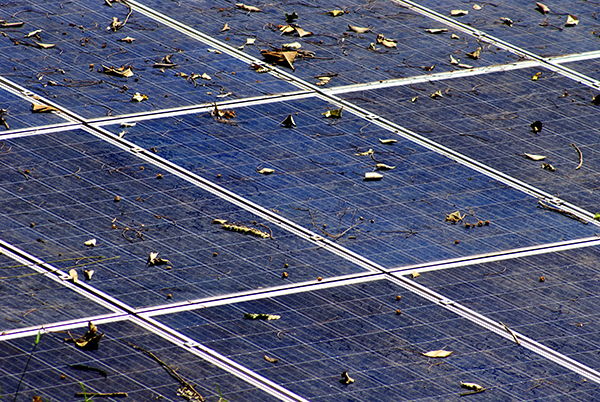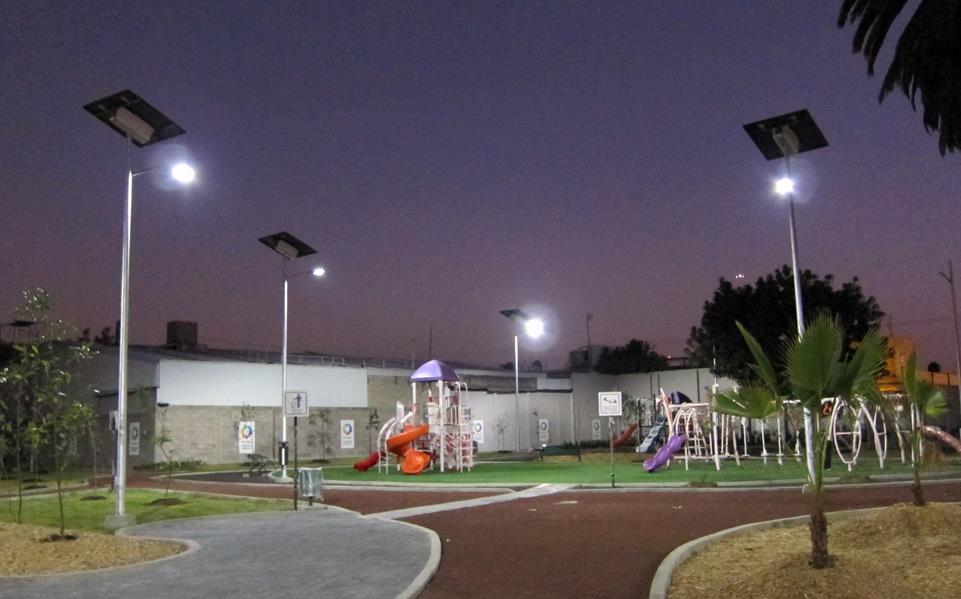Solar lights are extraordinary inventions that reduce carbon footprint up to 15,000 pounds a year if your house is a typical five-kilowatt residential property. Solar lights are like normal lights, but instead of using fossil fuel-generated electricity, they are fueled by the sun. They use rays from the sun to collect energy to power systems and devices.
How Does Solar Power Work?
Actually, it is simply smart science. Solar lights, along with the solar panels, can illuminate your house or garden without being harmful to the environment. The photovoltaic solar panel absorbs the waves from the sun and turns them into electricity; the inverter stores these waves and the LED bulb provides illumination. All these parts combine and help us harvest the sun’s free energy, as even the smallest of our actions can have a meaningful impact on the planet.
Solar energy is not limited to lighting; it is strong enough to supply entire houses for more than eight hours and that depends on how many panels you have. Using solar energy to power solar lights is one of the most common uses of solar energy. There are a lot of things that can affect how long a solar light lasts, so let’s see how long the batteries can hold out before you need replacement batteries.
How Long Do Solar Lights Last?
Solar panels are usually placed outdoors and are comprised of multiple parts and each has a different life expectancy. The bulbs you use can drastically affect how long your battery lasts. LEDs use 85 percent of the electricity to generate light, they are more efficient and smaller in size. When you compare an LED bulb with a halogen bulb, you can see that 90 percent of the electricity is used to produce heat in a halogen bulb. A typical LED bulb lasts about 50, 000 hours which is about 11 to 12 years on average if the light stays on for 12 hours each day. The LED lights are durable and made of plastic which is why they can last in extreme weather.
Photovoltaic Arrays
Arrays capture the rays of the sun and convert them into electricity. Different types of substances can cover the panels and each of these materials has a different life span. Let’s look at some of the materials that cover outdoor solar panels.
Epoxy Resin
Outdoor solar panels with epoxy resin typically have three layers. A resin surface, underneath which is a solar cell, and lastly a circuit board. They are inexpensive and generally last up to 2 years.
PET Panels
PET is a polyester film that lets 95 percent of light through and is more durable than resin. Their surface has more texture and are glossier. These solar lights last up to 3 years.
Tempered glass
Tempered glass panels are high-end outdoor lights; they are more durable and are ideal for harsh weather. Tempered glass solar lights can last 10-15 years; a very long time when compared with the life of PET and Epoxy resin panels.
A controller is another integral part of the solar light. It sends stored waves from the panel to the battery as well as signals when it is dark so that the LED light can turn on. The life of the controller depends on the type of brand you choose. A typical controller lasts up to 5 years.
Check The Batteries
In most instances of solar-powered lights not working, it is the batteries at fault. There are two common types of rechargeable batteries that are used in a solar panel. NiCd battery or a nickel-cadmium battery. This battery has several advantages. They have shorter charging times; usually it is only 2 hours.
Nickel-cadmium batteries can be charged up to 400 to 500 hundred times which ends up being about a year and a half. NiMH (Nickel-metal hydride) batteries store almost twice the amount of power that NiCd batteries do. They last longer and are not affected by temperature change. NiMH batteries are made of hydrogen and are considered environmentally friendly and non-toxic. NiCd batteries, on the other hand, are toxic and need to be correctly disposed of. These batteries are pricey but perform much better.
How Long Do the Solar Lights Last During the Night?
The solar lights can last night-long depending on how long they’ve been charged. If they have sufficiently charged – which typically takes about 8 hours – then the lights will stay on throughout the night and turn on when natural light dims around sunset.
Can You Make Your Solar Lights Last Longer?
Aside from the materials, there are also some user errors that can result in solar lights burning out quicker than normal. So, what do we do to make our solar lights last longer?
Choose Lights That Fit Your Space
You need ascertain your space is and buy lights accordingly. The size of the space you wish to illuminate is an important aspect to consider. If you wish to illuminate your garden, then measure your garden space and choose outdoor solar lighting of appropriate size. A simple measurement around the perimeter will help you with your buying decision.
Keep Your Panels Clean
 How long do you think your solar lights will last if they are dirty? You need to keep your panels clean because they need to be spotless to absorb the light efficiently. If it is dirty, the light will not be able to absorb properly, resulting in the battery draining faster. Place them around the perimeter of your house so they do not get dirty or get covered with plants. Placing them so can also enhance the outline of your garden and allow people to take notice of your landscape.
How long do you think your solar lights will last if they are dirty? You need to keep your panels clean because they need to be spotless to absorb the light efficiently. If it is dirty, the light will not be able to absorb properly, resulting in the battery draining faster. Place them around the perimeter of your house so they do not get dirty or get covered with plants. Placing them so can also enhance the outline of your garden and allow people to take notice of your landscape.
Place Them in Direct Sunlight
The solar lights need to be placed in a space where there is direct sunlight so that they can absorb the sunlight properly. If your lights don’t absorb the sun adequately, they will not shine properly. If your solar lights do not charge as long as they need to, it can damage the battery and cause it to die much faster.
Be Cautious of Cold Conditions
Many people ask: how long do solar lights last in cold conditions? The answer is not complicated. Most solar panels are very easily damaged in cold weather. If you want your solar lights to last longer, you need to take care of them and bring them inside when the temperature is below freezing in your area. Bring them inside when it is cold, so that you may prolong the life of the batteries. Store solar lights in a place where house lighting or direct sunlight is ample, so that the battery maintains a charge and does not burn out.
Switch the Solar Lights Off
Another way to extend battery life is by making sure you turn your battery off when there are long periods of rain or cloudy conditions. The batteries and solar light last longer if you turn them off when not needed. If it is too windy outside or there is a chance of a storm, the lights should be placed inside because the panels are delicate and could be damaged.
Replace Faulty Batteries
If you want to protect your solar lights and make your solar lights last longer, replace the battery as soon as it starts to slow down. The battery can corrode or grow old and as a result, it grows dim or stops working. It is essential that one should replace the battery when it gets old and is no longer able to recharge, so that we can preserve the health of the rest of the panel.
Solar Lights Stopped Working?
When a solar light stops working, most of the time the batteries at fault. Even good batteries die as they grow old. If your solar light has stopped working, it may indicate the end of the battery.
Full Charge?
Another common reason the batteries stop working is when solar lights are not getting charged, something which affects the health and life of your battery. The reason could also be moisture buildup that is fouling up your solar lights and in turn, adversely affecting their ability to function.
Why Choose Solar Lights?
Let’s dive a little deeper to see why we should choose solar lighting instead of traditional.
There are about 8 billion people on the planet, and a limit to how much energy can be produced using fossil fuels. The sun is the source of all life, in contrast, reaching everywhere as a free and readily-accessible source of power generation.
Another reason is that if we use an alternative source of energy we can reduce our overall carbon footprint. Solar lights are also easy to take care of. You have to keep lights clean and bring them inside during extreme conditions, but aside from that, the lights provide more returns than the upkeep required.
Going Green Saves Money
Solar panels are not as expensive as some people think. Because of the growing awareness of green energy, many companies have started to manufacture solar panels, resulting in a decline in prices due to competition amongst manufacturers. If you choose to install solar lights, expect your electricity bill to be lower.
Wrapping Up
Solar lights work and are a great investment, especially after reaping the rewards of the money invested. Sunlight is a free source of power easily accessed. Solar lights are kind to the environment and reduce carbon footprint, a leading cause of global warming.
How long do solar lights last depends on the materials you choose. The type of panels, illumination, bulbs, and battery are all important aspects to long solar life that you cannot overlook when buying solar lights. While the life of solar lights depends on the materials used, how you take care of the panels every time is equally important in ensuring the longevity of the lights for years.
If you keep them clean, fully charged with sunlight and bring them inside during bad weather so the lights work, the lighting will a long time. Using solar lighting shows you care about the environment while providing economical illumination for years.
What do you think? Leave a comment below.
